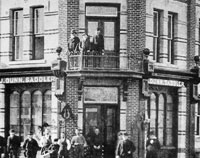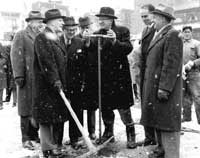 After another year of wrangling, the municipality accepted the offer of the building and lands.
After another year of wrangling, the municipality accepted the offer of the building and lands.
A new market building, designed by Samuel Peters, was constructed in 1853, and the town then purchased land on Richmond Street, adjoining the market, for the new city hall. It was built to face both the street and the market. The new market soon became a landmark and an extensive commercial area developed around the market square that served both farmers and market customers.
The market district remained the busiest part of the downtown until well into the 1920s. Hundreds of farmers appeared on market days to sell at the turn of the century. Around 1900, the city's first bank branches opened on the market and, in the 1920s, the first self-serve grocery stores, such as Dominion, opened on market square.
After WW II, there was some debate about the need for a market. Downtown merchants were beginning to feel competition from new suburban plazas and many believed a parking building  would be a better use for the land. A parking building with space for the market vendors was finally agreed to. The Chamber of Commerce supported the plan and, with the city's backing, the Covent Garden Parking Corporation was formed. The company, whose officers, lead by President Joseph Jeffery, served without compensation, sold bonds to finance the million dollar parking building and market. Many of the bonds were taken up by local merchants, who like the merchants of 1845 resolved not to let the market (or the parking) disappear from their vicinity. The new building opened late in 1956.
would be a better use for the land. A parking building with space for the market vendors was finally agreed to. The Chamber of Commerce supported the plan and, with the city's backing, the Covent Garden Parking Corporation was formed. The company, whose officers, lead by President Joseph Jeffery, served without compensation, sold bonds to finance the million dollar parking building and market. Many of the bonds were taken up by local merchants, who like the merchants of 1845 resolved not to let the market (or the parking) disappear from their vicinity. The new building opened late in 1956.
The decision to build a parking garage with space for the vendors allowed the market to survive to the present day. Its recent redevelopment has been driven by a new market's potential to assist the revival of the downtown.
